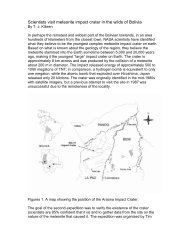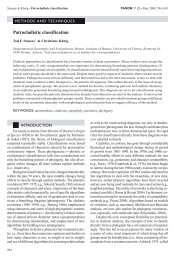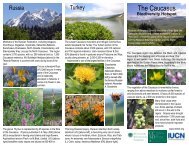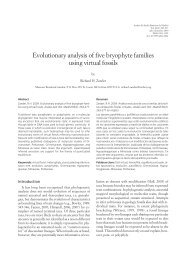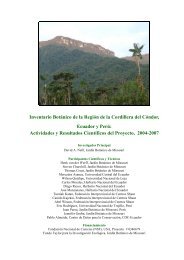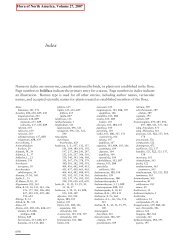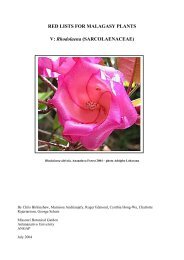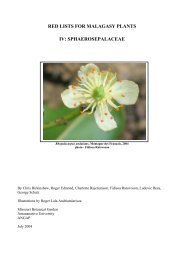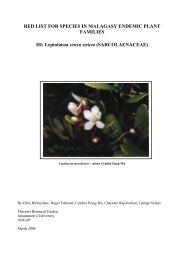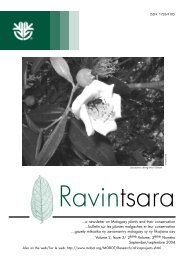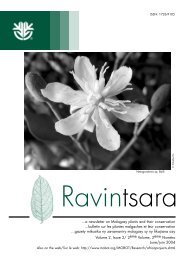phylogeny of campanulaceae s. str. inferred from its sequences of ...
phylogeny of campanulaceae s. str. inferred from its sequences of ...
phylogeny of campanulaceae s. str. inferred from its sequences of ...
Create successful ePaper yourself
Turn your PDF publications into a flip-book with our unique Google optimized e-Paper software.
556 Annals <<strong>str</strong>ong>of</<strong>str</strong>ong> the<br />
Missouri Botanical Garden<br />
highlight major discontinuities at the generic, tribal,<br />
and subtribal levels. Many species have been<br />
placed, for convenience, in Campanula L., Asyneuma<br />
Grisebach & Schenk, and Wahlenbergia Schrad.<br />
ex W. Roth, and this has further complicated our<br />
understanding <<strong>str</strong>ong>of</<strong>str</strong>ong> phylogenetic relationships. Indeed,<br />
some <<strong>str</strong>ong>of</<strong>str</strong>ong> the intrageneric taxa in these large<br />
genera are probably more deserving <<strong>str</strong>ong>of</<strong>str</strong>ong> generic status<br />
than some <<strong>str</strong>ong>of</<strong>str</strong>ong> the currently recognized segregate<br />
genera. The so-called satellite genera <<strong>str</strong>ong>of</<strong>str</strong>ong> Campanula<br />
do not appear to be any closer to each other<br />
than they do to Campanula, and there is no evidence<br />
to suggest that Campanula, despite <strong>its</strong> numerical<br />
superiority, is ance<strong>str</strong>al to them. It is thus<br />
<<strong>str</strong>ong>of</<strong>str</strong>ong>ten easier to define what Campanula is not rather<br />
than what <strong>its</strong> actual boundaries are. Thus, to some<br />
extent, the genus Campanula is conceptually useless<br />
and <strong>its</strong> continued use as a ‘‘core’’ genus may<br />
be misleading. The same is probably true for Asyneuma<br />
and Wahlenbergia.<br />
Knowledge <<strong>str</strong>ong>of</<strong>str</strong>ong> inter- and intrageneric relationships<br />
within the family has steadily increased during<br />
the latter half <<strong>str</strong>ong>of</<strong>str</strong>ong> the 20th century. Cytological<br />
studies, beginning with the seminal investigations<br />
<<strong>str</strong>ong>of</<strong>str</strong>ong> Gadella (1962, 1963, 1964, 1966, 1967), Contandriopoulos<br />
(1964, 1966, 1970, 1971, 1972,<br />
1976, 1980a, b, 1984), Contandriopoulos et al.<br />
(1972, 1974, 1984), Damboldt (1965a, b, 1966,<br />
1968, 1969, 1970, 1975, 1976, 1978a, b), Phitos<br />
(1963a, b, 1964a, b, 1965), and Podlech and Damboldt<br />
(1964) have vastly increased our knowledge<br />
<<strong>str</strong>ong>of</<strong>str</strong>ong> intrageneric relationships, particularly <<strong>str</strong>ong>of</<strong>str</strong>ong> the genus<br />
Campanula. The most common chromosome<br />
number in the Campanulaceae is n 17, and this<br />
appears to have evolved independently several<br />
times in relatively unrelated genera (e.g., in Campanula,<br />
Nesocodon M. Thulin, O<strong>str</strong>owskia Regel,<br />
and Canarina L.). Forty-two percent <<strong>str</strong>ong>of</<strong>str</strong>ong> the published<br />
chromosome counts <<strong>str</strong>ong>of</<strong>str</strong>ong> the family Campanulaceae<br />
s.l. have this number (Lammers, 1992).<br />
The base number in the family has been suggested<br />
to be x 8 (Böcher, 1964; Contandriopoulos,<br />
1984), but Raven (1975) suggested that x 7is<br />
the ance<strong>str</strong>al number. An ance<strong>str</strong>al base number <<strong>str</strong>ong>of</<strong>str</strong>ong><br />
x 7 is supported by counts for Cyananthus (Kumar<br />
& Chauhan, 1975; Hong & Ma, 1991).<br />
It was Avetisian (1948, 1967, 1973, 1986) who<br />
first drew attention to the different pollen morphologies<br />
within the family and gave a schematic presentation<br />
<<strong>str</strong>ong>of</<strong>str</strong>ong> pollen evolution based on aperture<br />
types. She further pointed out that pollen with colpate<br />
and colporate apertures are typical <<strong>str</strong>ong>of</<strong>str</strong>ong> those<br />
taxa found in the tropics, whereas those with porate<br />
apertures are typical <<strong>str</strong>ong>of</<strong>str</strong>ong> taxa <strong>from</strong> temperate regions.<br />
Dunbar (1973a, b, c, 1975a, b, 1981, 1984)<br />
and Dunbar and Wallentinus (1976) extended Avetisian’s<br />
work by providing excellent surveys <<strong>str</strong>ong>of</<strong>str</strong>ong> pollen<br />
<strong>from</strong> numerous genera <<strong>str</strong>ong>of</<strong>str</strong>ong> the Campanulaceae,<br />
and this has been augmented by Morin (1987),<br />
Nowicke et al. (1992), and Morris and Lammers<br />
(1997). Several <<strong>str</strong>ong>of</<strong>str</strong>ong> these studies suggest that some<br />
<<strong>str</strong>ong>of</<strong>str</strong>ong> the genera are artificially grouped together in De<br />
Candolle’s and in Schönland’s arrangements because<br />
<<strong>str</strong>ong>of</<strong>str</strong>ong> the limited criteria used as the basis for<br />
their classification systems.<br />
Seed morphology has been examined for a number<br />
<<strong>str</strong>ong>of</<strong>str</strong>ong> taxa, principally those <<strong>str</strong>ong>of</<strong>str</strong>ong> North America<br />
(Shetler & Morin, 1982, 1986) and Eurasia (Belyaev,<br />
1984a, b, 1985, 1986; Oganesian, 1985).<br />
Life-form in the Campanulaceae has been studied<br />
intensively by Shulkina (1974, 1975a, b, 1977,<br />
1978, 1979, 1980a, b, c, 1986a, b, 1988) and<br />
Shulkina and Zykov (1980), but these data have not<br />
been incorporated into a cladistic analysis. Serological<br />
studies have been done on the tribe Phyteumatae<br />
(Gudkova & Borshchenko, 1991), while<br />
Gorovoi et al. (1971) conducted a limited chemotaxonomic<br />
survey <<strong>str</strong>ong>of</<strong>str</strong>ong> Russian Far-Eastern taxa. Kolakovsky<br />
(1980, 1982, 1986a, 1986b, 1987), Kolakovsky<br />
and Serdyukova (1980), and Lakoba<br />
(1986) did some pioneering carpological investigations<br />
<<strong>str</strong>ong>of</<strong>str</strong>ong> the family, but so far this work has not<br />
been corroborated and it remains to be seen whether<br />
their segregate genera will be accepted.<br />
Few molecular phylogenetic studies <<strong>str</strong>ong>of</<strong>str</strong>ong> the Campanulaceae<br />
have been undertaken. Cosner (1993)<br />
and Cosner et al. (2004) used chloroplast DNA<br />
(cpDNA) <strong>str</strong>uctural rearrangements to establish a<br />
<<strong>str</strong>ong>phylogeny</<strong>str</strong>ong> <<strong>str</strong>ong>of</<strong>str</strong>ong> the family based on 18 genera, while<br />
Cosner et al. (1994) determined rbcL <strong>sequences</strong> for<br />
several genera as part <<strong>str</strong>ong>of</<strong>str</strong>ong> a study <<strong>str</strong>ong>of</<strong>str</strong>ong> interfamilial<br />
relationships <<strong>str</strong>ong>of</<strong>str</strong>ong> the Campanulales. Eddie (1997,<br />
and unpublished data), using cladistic and phenetic<br />
methodologies, investigated the morphology <<strong>str</strong>ong>of</<strong>str</strong>ong> most<br />
<<strong>str</strong>ong>of</<strong>str</strong>ong> the genera <<strong>str</strong>ong>of</<strong>str</strong>ong> the Campanulaceae, in addition to<br />
molecular variation <<strong>str</strong>ong>of</<strong>str</strong>ong> 23 to 29 taxa using internal<br />
transcribed spacers (ITS) and matK/trnK-intron sequence<br />
data <strong>from</strong> nuclear ribosomal (nrDNA) and<br />
cpDNA, respectively. For molecular variation within<br />
and between genera, ITS <strong>sequences</strong> have been<br />
used by Ge et al. (1997) for Adenophora Fisch. and<br />
by Kim et al. (1999) for Hanabusaya Nakai. Haberle<br />
(1998) examined relationships among the<br />
families Campanulaceae, Cyphiaceae, Nemacladaceae,<br />
Cyphocarpaceae, and Lobeliaceae using ITS<br />
sequence data.<br />
This study is an attempt to recon<strong>str</strong>uct the <<strong>str</strong>ong>phylogeny</<strong>str</strong>ong><br />
<<strong>str</strong>ong>of</<strong>str</strong>ong> the Campanulaceae s. <strong>str</strong>. using nrDNA<br />
ITS <strong>sequences</strong> and to compare the results with certain<br />
characters that have traditionally been used in





